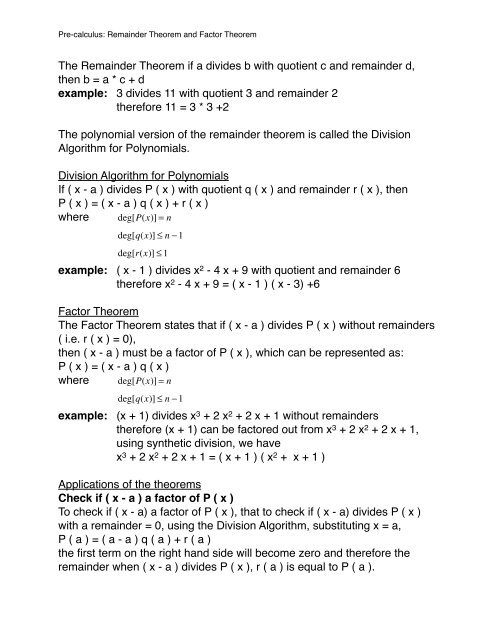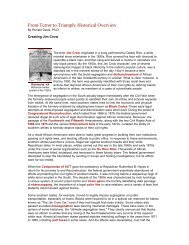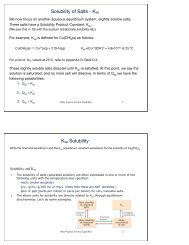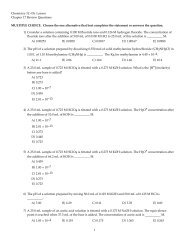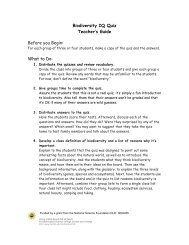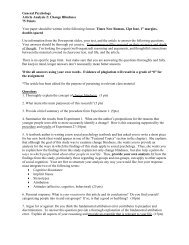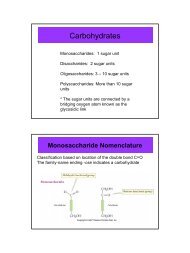The Remainder Theorem if a divides b with quotient c and ...
The Remainder Theorem if a divides b with quotient c and ...
The Remainder Theorem if a divides b with quotient c and ...
You also want an ePaper? Increase the reach of your titles
YUMPU automatically turns print PDFs into web optimized ePapers that Google loves.
Pre-calculus: <strong>Remainder</strong> <strong>The</strong>orem <strong>and</strong> Factor <strong>The</strong>orem<br />
<strong>The</strong> <strong>Remainder</strong> <strong>The</strong>orem <strong>if</strong> a <strong>divides</strong> b <strong>with</strong> <strong>quotient</strong> c <strong>and</strong> remainder d,<br />
then b = a * c + d<br />
example:! 3 <strong>divides</strong> 11 <strong>with</strong> <strong>quotient</strong> 3 <strong>and</strong> remainder 2<br />
! ! therefore 11 = 3 * 3 +2<br />
<strong>The</strong> polynomial version of the remainder theorem is called the Division<br />
Algorithm for Polynomials.<br />
Division Algorithm for Polynomials<br />
If ( x - a ) <strong>divides</strong> P ( x ) <strong>with</strong> <strong>quotient</strong> q ( x ) <strong>and</strong> remainder r ( x ), then<br />
P ( x ) = ( x - a ) q ( x ) + r ( x )<br />
where! deg[P(x)] = n<br />
! ! deg[q(x)] ≤ n − 1<br />
! ! deg[r(x)] ≤ 1<br />
example:! ( x - 1 ) <strong>divides</strong> x 2 - 4 x + 9 <strong>with</strong> <strong>quotient</strong> <strong>and</strong> remainder 6<br />
! ! therefore x 2 - 4 x + 9 = ( x - 1 ) ( x - 3) +6<br />
Factor <strong>The</strong>orem<br />
<strong>The</strong> Factor <strong>The</strong>orem states that <strong>if</strong> ( x - a ) <strong>divides</strong> P ( x ) <strong>with</strong>out remainders<br />
( i.e. r ( x ) = 0),<br />
then ( x - a ) must be a factor of P ( x ), which can be represented as:<br />
P ( x ) = ( x - a ) q ( x )<br />
where! deg[P(x)] = n<br />
! ! deg[q(x)] ≤ n − 1<br />
example:! (x + 1) <strong>divides</strong> x 3 + 2 x 2 + 2 x + 1 <strong>with</strong>out remainders<br />
! ! therefore (x + 1) can be factored out from x 3 + 2 x 2 + 2 x + 1,<br />
! ! using synthetic division, we have<br />
! ! x 3 + 2 x 2 + 2 x + 1 = ( x + 1 ) ( x 2 + x + 1 )<br />
Applications of the theorems<br />
Check <strong>if</strong> ( x - a ) a factor of P ( x )<br />
To check <strong>if</strong> ( x - a) a factor of P ( x ), that to check <strong>if</strong> ( x - a) <strong>divides</strong> P ( x )<br />
<strong>with</strong> a remainder = 0, using the Division Algorithm, substituting x = a,<br />
P ( a ) = ( a - a ) q ( a ) + r ( a )<br />
the first term on the right h<strong>and</strong> side will become zero <strong>and</strong> therefore the<br />
remainder when ( x - a ) <strong>divides</strong> P ( x ), r ( a ) is equal to P ( a ).
Pre-calculus: <strong>Remainder</strong> <strong>The</strong>orem <strong>and</strong> Factor <strong>The</strong>orem<br />
example:! Is ( x - 2 ) a factor of P ( x ) = x 3 + 2 x 2 + 2 x + 1 ?<br />
! ! To check this, we put x = 2 <strong>and</strong> compute the value of the<br />
! ! polynomial.<br />
! ! P ( 2 ) = (2) 3 + 2 (2) 2 + 2 (2) + 1 = 21<br />
! ! Since P ( 2 ) does not equal to 0, ( x - 2 ) is not a factor of<br />
! ! P ( x ).<br />
To compute the value of P ( k ) (k is a constant)<br />
This is the reverse process of the first application. Using the Division<br />
Algorithm, substituting x = k,<br />
P ( k ) = ( k - k ) q ( k ) + r ( k )<br />
the first term on the right h<strong>and</strong> side will become zero <strong>and</strong> therefore the<br />
functional value P ( k ) is equal to the remainder when P ( x ) is divided by<br />
( x - k ).<br />
example:! Find the value of P ( k ) for given conditions:<br />
! ! P ( x ) = f ( x ) + g ( x )<br />
! ! <strong>The</strong> remainder of f ( x ) divided by ( x - k ) is a<br />
! ! <strong>The</strong> remainder of g ( x ) divided by ( x - k ) is b<br />
! !<br />
! ! Applying Division Algorithm on f ( x ) <strong>and</strong> g ( x ),<br />
! ! f ( x ) = ( x - k ) q1 ( x ) + r1 ( x )<br />
! ! g ( x ) = ( x - k ) q2 ( x ) + r2 ( x )<br />
! ! Substituting x = k on both sides,<br />
! ! f ( k ) = ( k - k ) q1 ( x ) + r1 ( k ) = r1 ( k )<br />
! ! g ( k ) = ( k - k ) q2 ( x ) + r2 ( k ) = r2 ( k )<br />
! ! Since r1 ( k ) = a, r2 ( k ) = b,<br />
! ! f ( k ) = a<br />
! ! g ( k ) = b<br />
! ! <strong>The</strong>refore using the fact that !P ( x ) = f ( x ) + g ( x )<br />
! ! P ( k ) = f ( k ) + g ( k ) = a + b


